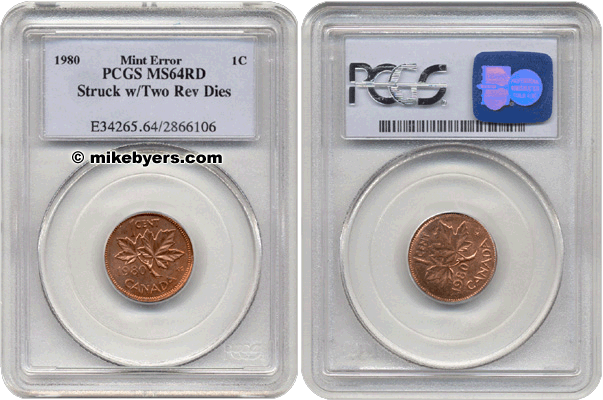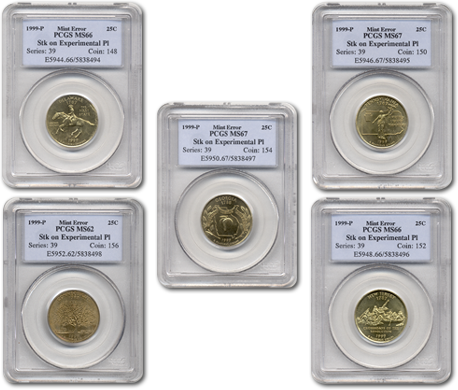| q. |
Where can I sell my rare U.S. gold coins?
|
| a. |
We are one of the largest Numismatic corporations dealing in U.S. Gold Coins, Patterns and Rarities certified by PCGS and NGC. Mike Byers has purchased millions of dollars of rare United States gold coins and collections. For over 35 years we have been Market-Makers in U.S. gold coins. We buy and sell proof gold, mint state gold, gold commems and early gold. In 1987, Mike Byers Inc was one of the FIRST major U.S. dealers to offer SEC approved Limited Partnerships / Rare Coin Funds. We purchased major rarities including proof gold, early type gold, and gem mint state gold. Our ads soliciting investors appeared in the Wall Street Journal, Coin World, and other publications. Later on, many coin dealers followed our lead and offered Limited Partnerships as well. Mike Byers is the largest error coin dealer with the most extensive inventory of U.S. and World error coins. Visit our selling page for more information.
|
| q. |
Where can I buy and sell my fine art paintings and original works?
|
| a. |
Mike Byers Inc is a dealer in fine art. We specialize in original pieces by Leroy Neiman, Peter Max, Erte and Robert Wyland. Most of the pieces we handle are oil and acrylics on canvas and board, bronzes, watercolors and mixed media artwork. Please visit our art website, mikebyers.vegas.
|
| q. |
Where can I find information about mint errors?
|
| a. |
Visit minterrornews.com where you can find out the latest news, discoveries and features as well as download the latest edition of Mint Error News Magazine.
|
| q. |
I have a pattern, die trial or test piece that has been in my collection for years. What it the best way to sell it?
|
| a. |
Mike Byers Inc handles almost every pattern, test piece and die trial that is listed in the Judd reference book. In addition we handle splashers, hub trials and other unique numismatic items. Please offer us what you have.
|
| q. |
I have a two headed coin. Is this a rare mint error? If so what is it worth?
|
| a. |
What you have is called a "magician's coin." This is a novelty piece and can be purchased at a magic shop. These have no numismatic value and are for entertainment only. There are approximately thirty genuine two-headed or two-tailed coins that have been authenticated by ANACS, PCGS and NGC. There are only four known "Two Tailed" U.S. coins: three Quarters and one Dime. One of the Quarters recently sold for $80,000. Two of the world coins are Canadian Copper Cents that were struck with two reverse dies and authenticated by PCGS. These were part of a Canadian Mint Error Collection and were featured in a front page Coin World article.

|
| q. |
I think I found an error coin, what type of errors are there? Where can I quickly look up information?
|
| a. |
Visit our glossary section for information on different categories of error coins.
|
| q. |
I've been collecting mint error coins for years and want to have my collection certified. How do I go about doing this?
|
| a. |
There are three major third party grading services that authenticate, certify and encapsulate mint errors:
- ANACS - ANACS has been certifying major mint errors for thirteen years. They have an excellent track record and have slabbed many of the finest errors in the world. Thousands of mint error collectors rely on ANACS's reputation to certify their mint errors.
- PCGS - PCGS is one of the largest third party grading services and started certifying mint errors in March of 1999. They are located in California.
- NGC - NGC is one of the largest third party grading services located in Florida and have been certifying mint errors for two years.
Once you have certified your major mint errors at PCGS, NGC or ANACS, please contact me for my highest offer.
|
| q. |
I collect mint error coins but I am confused by some of the abbreviations used by the grading services when describing the error. Could you please help me out?
|
| a. |
Here is the generally accepted list, and primarily used by ANACS, PCGS & NGC:
O/C - off center, D/S - double struck, T/S - triple struck, M/S - multi struck, F/O - flipover, B/S - broadstruck, DBL DENOM - double denomination, CB - counterbrockage, FRAG - fragment, BROCK - brockage, TRANS - transitional, EXP - experimental, PLN - planchet, TR - trial, ADJ - adjustment, STK - struck, PC - partial collar, BND - bonded, MTD PR - mated pair, T1 - type 1.
|
| q. |
I found a coin that shows doubling of the letters, design and portrait. Is this a double die or a double struck coin?
|
| a. |
What you most likely have is a coin with mechanical doubling, ejection doubling, or strike doubling. This is very common and has little or no value as a mint error.
|
| q. |
I just found a State Quarter that looks like it's golden or brass. Is this made out of the same metal as the new golden dollar?
|
| a. |
Chances are your State Quarter has been plated after it left the Mint. Check to see if the edge is the same color as the rest of the coin. If it is the same color, the coin has been plated. If the edge is copper colored you might have genuine a mint error. Please e-mail a picture to allow us to evaluate your coin. There are approximately 15 known 1999 State Quarters struck on Experimental Planchets. All five states in the 1999 series (DE, PA, CT, GA and NJ) have been discovered. These Experimental State Quarters have sold for as high as $10,000 each, depending on which state, the coin's condition and which type of experimental composition was used. There are four known types of experimental compositions which have been discovered so far on 1999 State Quarters.
Discovered by Mike Byers:

|
|
| q. |
I found a penny (nickel or dime) that looks slightly misshaped or a little off-center. Is this error worth anything? How can I sell it?
|
| a. |
Most minor errors on the smaller denominations are common and are only worth a few dollars. Either keep it as a souvenir or sell it on eBay.
|
| q. |
How are error coins made?
|
| a. |
Error coins are mistakes made at official government mints which escaped detection before leaving the facility. There are many types of errors, you can find more information on the different types in our glossary section.
|
| q. |
I have a half dollar, quarter and/or dime that is copper on one side. What is it?
|
| a. |
Since 1965 our dimes, quarters, halves, and dollars are made of "clad" material. This is a copper core surrounded on both sides by a cupro-nickel layer. Very often the clad layer peels off the coin before or after it is struck. On dimes and pre-1999 quarters, "Missing Clad Layers" are worth between $10-$25. On States quarters, depending on the condition of the coin and the color of the copper side, they are worth between $100- $200. Do not clean your coin, especially the copper side. |





